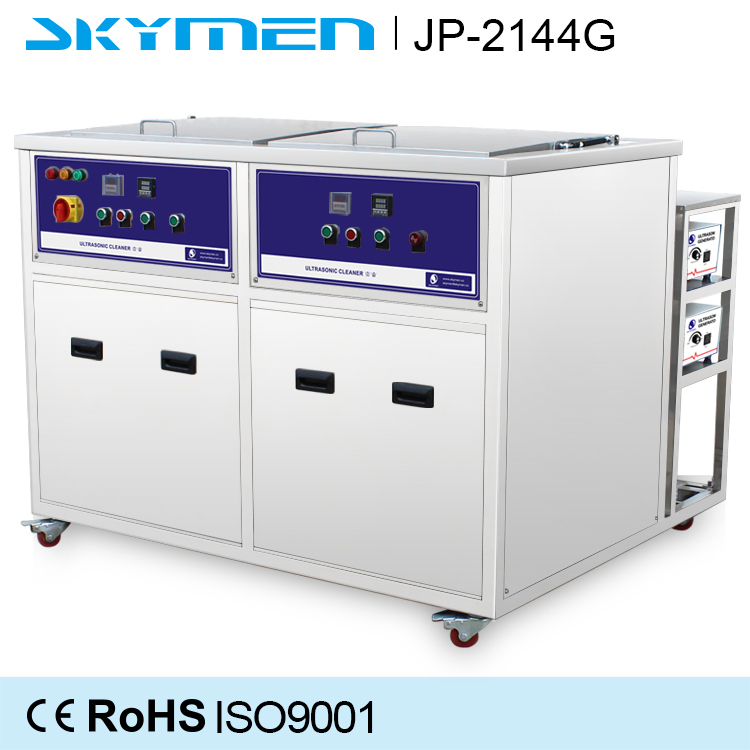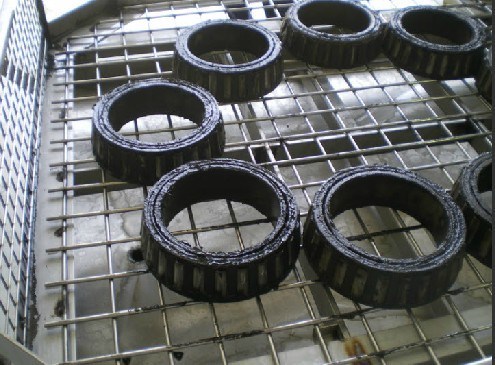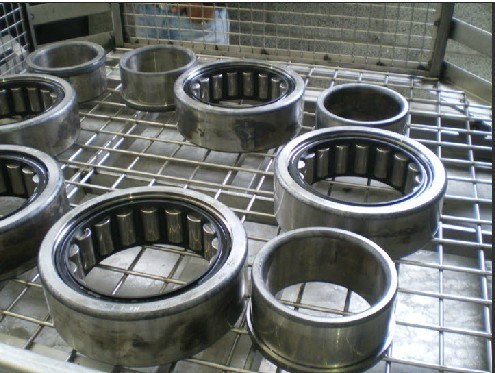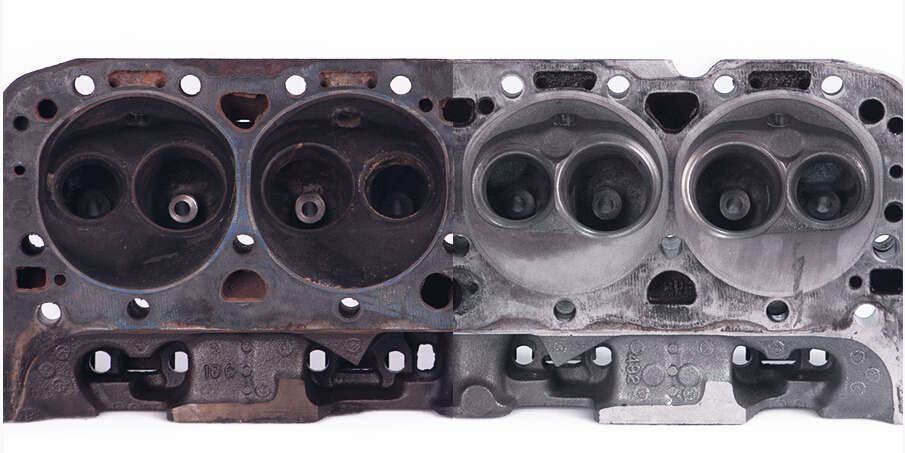
Â
| Â Model | Â JP-2048G | Â JP-2072G | Â JP-2144G |
| 1st Tank size | Â 550*400*350 | Â 600*500*450 | Â 1000*600*600 mm |
| 2rd Tank size | Â 550*400*350 | Â 600*500*450 | Â 1000*600*600 mm |
| Capacity | 77L | 135L | 264L |
| Transducers | 48 | Â 72 | 144 |
| Ultrasonic power (W) | Â 2400 | Â 3600 | 7200 |
| Heating power(W) | 3000 | Â 4500 | 9000 |
| Frequency | Â Â Â 28K OR 40Khz | ||
| Tank material | Â Â Â 304 stainless steel | ||
| Tank thickness | Â Â Â 2.5 mm | ||
| Timer | Â Â Â 1s-99 hours | ||
| Heater |    20-95°C | ||
| Drain valve | Â Â Â 1 inch | ||
| Basket &Â Lid | Â Â Â Yes | ||
| Machine Voltage | Â Â Â 380V/3 phase | ||
| Features | Â Â With castor | ||
| Packing | Â Â Carton | ||
Special Features:
Stainless Steel Construction ensures solidness and durability;
High efficiency transducer;
Twin Tank ,one for cleaning and one for rinsing ,to achieve better cleaness effect;
All Components are Easily Accessed for Maintenance Operations;
Fiberglass Control Enclosure Provides Ease of Operation while Eliminating Potential Corrosion;
Digital Ultrasonic Timer Included as Standard Equipment;
Filtration system /Â customized size is available.
How ultraosnic cleaner works:
Electrical energy is converted into mechanical vibrations thanks to special elaborated transducers.These vibrations are transferred into the fluid through the walls of stainless steel.This creates tiny microscopic vacuum bubbles, which cause consecutive implosions (cavitation).The high-energy jets that are thus created can efficiently remove dirt from surfaces an materials placed in the cleaning bath.
An ultrasonic carburetor cleaner cleans even gummed up carburetors. Stop wasting time hand cleaning!
Fast and effective cleaning with no manual labor
Powerful enough to remove carbon deposits yet gentle on aluminum parts
Use water-based cleaning solutions, no toxic solvents
Ultrasonic parts cleaners remove dirt, oils, lubricants, carbon, and other types of grime that build up on engines and mechanical parts. Grooves, internal passageways, seals, and other hard to reach areas are cleaned easily, eliminating hours of disassembling and reassembling complex parts. Carburetors, pistons, cylinder heads, aluminum parts, and brake calipers are a few examples of components that are cleaned thoroughly with no manual scrubbing in an ultrasonic cleaner
There are so many uses for an ultrasonic cleaner in an auto shop. Ultrasonic car parts cleaning saves time by eliminating the need for manual scrubbing of auto parts covered with grease, oil, and other lubricants.
ultrasonic cleaner include filters, shock absorber parts, power steering parts, pistons, valves, fuel injectors, bearings - just to name a few. Larger industrial-sized units can be used for ultrasonic carburetor cleaning and ultrasonic exhaust manifold cleaning, where cleaning action is needed deep within the network of passages. This large capacity also allows for ultrasonic crankshaft cleaning and ultrasonic cylinder block cleaning as well the means to clean multiple parts at once.
Manual, automatic or fully automatic, the system offers the possibility of an individual and flexible assembly to achieve the best combination of required units for cleaning, rinsing and drying.
Can be extended step by step, at any moment, according to your needs and available budget.
Before and After:


FAQ
How should I clean large, dense metal objects in my ultrasonic bath?
When cleaning large, dense objects it is important that if at all possible they are submerged in the ultrasonic tank at an oblique angle. This allows the energy developed to rebound around the ultrasonic tank maximising the full potential of the cleaner. This is particularly important if the ultrasonic tank has only one radiating face, i.e. the base of the tank.
Â
Â
Why does my ultrasonic bath continue to heat beyond the set temperature?
The ultrasonic activity within the tank will increase the temperature by about 10-15°C over an hour period even if the heaters are not in operation. The cavitation creates energy which in turn creates heat.
Â
Can I use water alone in my ultrasonic bath?
Ultrasonic cleaning produces significantly better results when a detergent is used. We do not advise that water alone is used within the bath.
The correct detergent aids in the breakdown of decontamination while also reducing the surface tension of the bath and increasing ultrasonic activity.
What is the difference betwwen 28Khz and 40Khz?
Lower frequency produces larger cavitation bubbles which results in each implosion of a cavitation bubble having a higher energy level. As frequency is increased, the size of the cavitation bubbles becomes smaller which means that each bubble implosion will have relatively less energy. The difference in energy levels is compensated for by the fact that more cavitation bubbles are produced as the frequency is increased.
Higher ultrasonic cleaning is more gentle
Â

Â
| Â Model | Â JP-2048G | Â JP-2072G | Â JP-2144G |
| 1st Tank size | Â 550*400*350 | Â 600*500*450 | Â 1000*600*600 mm |
| 2rd Tank size | Â 550*400*350 | Â 600*500*450 | Â 1000*600*600 mm |
| Capacity | 77L | 135L | 264L |
| Transducers | 48 | Â 72 | 144 |
| Ultrasonic power (W) | Â 2400 | Â 3600 | 7200 |
| Heating power(W) | 3000 | Â 4500 | 9000 |
| Frequency | Â Â Â 28K OR 40Khz | ||
| Tank material | Â Â Â 304 stainless steel | ||
| Tank thickness | Â Â Â 2.5 mm | ||
| Timer | Â Â Â 1s-99 hours | ||
| Heater |    20-95°C | ||
| Drain valve | Â Â Â 1 inch | ||
| Basket &Â Lid | Â Â Â Yes | ||
| Machine Voltage | Â Â Â 380V/3 phase | ||
| Features | Â Â With castor | ||
| Packing | Â Â Carton | ||
Special Features:
Stainless Steel Construction ensures solidness and durability;
High efficiency transducer;
Twin Tank ,one for cleaning and one for rinsing ,to achieve better cleaness effect;
All Components are Easily Accessed for Maintenance Operations;
Fiberglass Control Enclosure Provides Ease of Operation while Eliminating Potential Corrosion;
Digital Ultrasonic Timer Included as Standard Equipment;
Filtration system /Â customized size is available.
How ultraosnic cleaner works:
Electrical energy is converted into mechanical vibrations thanks to special elaborated transducers.These vibrations are transferred into the fluid through the walls of stainless steel.This creates tiny microscopic vacuum bubbles, which cause consecutive implosions (cavitation).The high-energy jets that are thus created can efficiently remove dirt from surfaces an materials placed in the cleaning bath.
An ultrasonic carburetor cleaner cleans even gummed up carburetors. Stop wasting time hand cleaning!
Fast and effective cleaning with no manual labor
Powerful enough to remove carbon deposits yet gentle on aluminum parts
Use water-based cleaning solutions, no toxic solvents
Ultrasonic parts cleaners remove dirt, oils, lubricants, carbon, and other types of grime that build up on engines and mechanical parts. Grooves, internal passageways, seals, and other hard to reach areas are cleaned easily, eliminating hours of disassembling and reassembling complex parts. Carburetors, pistons, cylinder heads, aluminum parts, and brake calipers are a few examples of components that are cleaned thoroughly with no manual scrubbing in an ultrasonic cleaner
There are so many uses for an ultrasonic cleaner in an auto shop. Ultrasonic car parts cleaning saves time by eliminating the need for manual scrubbing of auto parts covered with grease, oil, and other lubricants.
ultrasonic cleaner include filters, shock absorber parts, power steering parts, pistons, valves, fuel injectors, bearings - just to name a few. Larger industrial-sized units can be used for ultrasonic carburetor cleaning and ultrasonic exhaust manifold cleaning, where cleaning action is needed deep within the network of passages. This large capacity also allows for ultrasonic crankshaft cleaning and ultrasonic cylinder block cleaning as well the means to clean multiple parts at once.
Manual, automatic or fully automatic, the system offers the possibility of an individual and flexible assembly to achieve the best combination of required units for cleaning, rinsing and drying.
Can be extended step by step, at any moment, according to your needs and available budget.
Before and After:


FAQ
How should I clean large, dense metal objects in my ultrasonic bath?
When cleaning large, dense objects it is important that if at all possible they are submerged in the ultrasonic tank at an oblique angle. This allows the energy developed to rebound around the ultrasonic tank maximising the full potential of the cleaner. This is particularly important if the ultrasonic tank has only one radiating face, i.e. the base of the tank.
Â
Â
Why does my ultrasonic bath continue to heat beyond the set temperature?
The ultrasonic activity within the tank will increase the temperature by about 10-15°C over an hour period even if the heaters are not in operation. The cavitation creates energy which in turn creates heat.
Â
Can I use water alone in my ultrasonic bath?
Ultrasonic cleaning produces significantly better results when a detergent is used. We do not advise that water alone is used within the bath.
The correct detergent aids in the breakdown of decontamination while also reducing the surface tension of the bath and increasing ultrasonic activity.
What is the difference betwwen 28Khz and 40Khz?
Lower frequency produces larger cavitation bubbles which results in each implosion of a cavitation bubble having a higher energy level. As frequency is increased, the size of the cavitation bubbles becomes smaller which means that each bubble implosion will have relatively less energy. The difference in energy levels is compensated for by the fact that more cavitation bubbles are produced as the frequency is increased.
Higher ultrasonic cleaning is more gentle
Â
Precautions for daily maintenance of hydraulic cylinders
1. Regularly inspect the sealing components of the hydraulic cylinder, such as O-rings and gaskets, to ensure that they are intact and undamaged. If there is wear or aging, they should be replaced in a timely manner.
2. Regularly check the liquid level of the hydraulic cylinder and keep it within the specified range. If the liquid level is too low, add hydraulic oil in a timely manner.
3. Regularly inspect the connection parts of the hydraulic cylinder, such as oil pipes and joints, to ensure their tightness and reliability. If there is any looseness, it should be tightened in a timely manner.
4. Regularly clean the outer surface of the hydraulic cylinder to prevent dust, sand, and other debris from entering the interior of the cylinder and affecting its normal operation.
5. Regularly inspect the surface of the piston rod of the hydraulic cylinder, and promptly repair or replace it if there are scratches or wear.
6. Regularly inspect the hydraulic system of the hydraulic cylinder, and promptly handle any problems such as oil leakage or unstable pressure.
7. When the hydraulic cylinder is not in use for a long time, its hydraulic oil should be drained to avoid oil aging, deterioration, and affecting the normal operation of the hydraulic system.
8. When repairing or replacing hydraulic cylinders, attention should be paid to safety to avoid sudden movement or pressure release of the hydraulic cylinder, which may cause personal injury or equipment damage.
For Liugong Cylinder Seal Kit,For Liugong Swing Motor Seal Kit,Center Joint Seal Kit For Liugong,Center Joint Seal Kit Liugong
Safe Seal Technology Co., Ltd. , https://www.jssafeseal.com